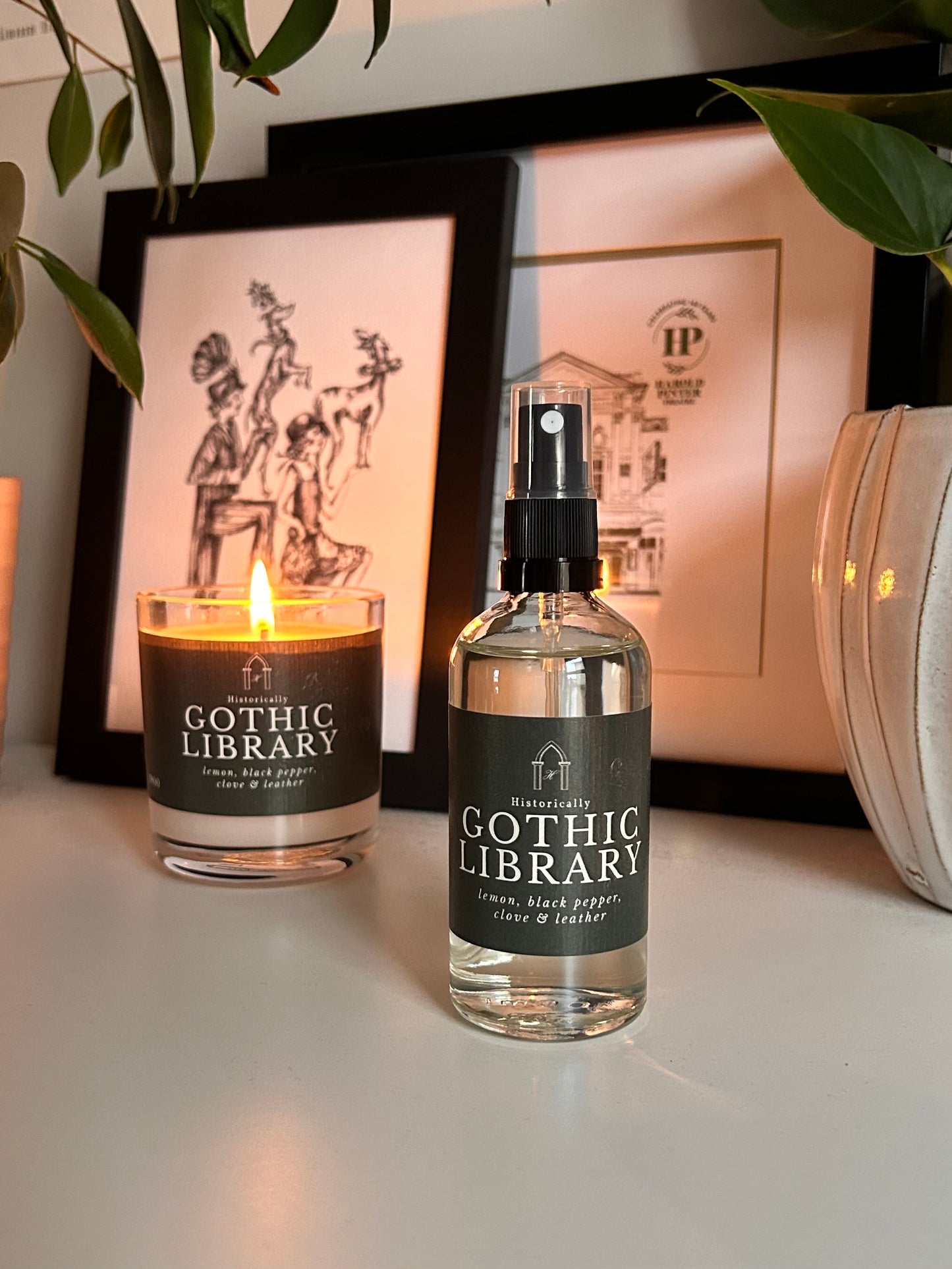Historically
Gothic Library Room Spray
Gothic Library Room Spray
Couldn't load pickup availability
Gothic Reverie at the John Rylands Library.
Immerse yourself in the mystical allure of a Victorian gothic library with this candle, designed to evoke the grandeur of Manchester's John Rylands Library. The crisp, invigorating scent of lemon cuts through the dusky air, while piquant black pepper and warm cloves mingle to recreate the spicy aroma of ancient, leather-bound tomes. The deep, rich essence of leather wraps these scents in a luxurious embrace, transporting you to a world of scholarly pursuits and gothic architectural majesty. This candle captures the essence of intellectual exploration surrounded by the awe-inspiring surroundings of one of the most stunning libraries from the Victorian era.
100ml Room Spray perfect for an immediate history fix.
Share
Scent Notes
Scent Notes
Lemon, black pepper, clove, black leather, cedar, vanilla and musk
Delivery & Returns
Delivery & Returns
Dispatch times
Our candles are made to order and most will take between 1-7 business days to dispatch.
However, if you are wanting your order sooner or for a specific date please get in touch (via email or in the message box at checkout) and we can sort something out for you!
Delivery Times
We currently offer standard delivery with Royal Mail 2nd class which should arrive between 2-3 days after dispatch and Royal Mail 1st class which should arrive between 1-2 days after dispatch.
NOTE: Please note that during the months of November and December we use Royal Mail Tracked. This is more expensive than normal but we have found means that your parcels are safe and get to you in time.
Shipping outside the UK
We are more than happy to ship to America and Australia, unfortunately we cannot ship to the EU at this time.
If you would like an order to be delivered to Australia please do not hesitate to contact us via our contact page, email or Instagram message and we will calculate the shipping costs for you and complete your order via invoice.
Please note that customers are responsible for paying any import VAT, taxes and fees.
What is your return policy?
Please note earrings cannot be returned and refunded for hygiene reasons.
We are happy to accept returns if you are unhappy with your purchase.
Contact us within: 14 days of delivery
Dispatch items back within: 30 days of delivery
Request a cancellation within: 24 hours of purchase
Buyers are responsible for return postage costs. If the item is not returned in its original condition, the buyer is responsible for any loss in value.
Item damaged in transit
Sometimes accidents happen.
If you receive a parcel that has been damaged in the post please send a picture to us showing the damage within 48 hours of your parcel being delivered and we can discuss options with you. No worries.
Safety Information
Safety Information
Shake well before use, Spray into the center of the room, away from eyes and face.
Keep out of reach of children and pets. Do not spray directly onto furnishings, naked flames or heat sources.
Avoid contact with polished/wooden surfaces/floor tiles.
DO NOT INGEST - IF SWALLOWED SEEK MEDICAL ATTENTION.
Store in a cool place and away from direct sunlight.
Danger. Highly flammable liquid
and vapour. Causes skin irritation. May cause
an allergic skin reaction. Causes serious eye irritation. Harmful to aquatic life with long lasting effects. Keep out of reach of children. Keep away from heat, sparks, open flames and hot surfaces. - No smoking. IF IN EYES: Rinse cautiously with water for several minutes. Remove contact lenses, if present and easy to do. Continue rinsing. If skin irritation or rash occurs: Get medical advice/attention. If eye irritation persists: Get medical advice/attention. Dispose of contents/container to approved disposal site in accordance with local regulations. In case of fire: Use foam for extinction. Store in a well-ventilated place. Keep cool.
Contains Hexyl cinnamic aldehyde; Vertenex; acetyl cedrene; Iso E Super; d-Limonene; Rosemary
Oil; Clove leaf oil ; Elemi oil; Linalyl acetate
Scent History
Scent History
Lemon:
Lemons have a rich history dating back to ancient times, believed to originate in Southeast Asia. Cultivated in India and China 2,500 years ago, they spread to the Middle East and were known to the ancient Egyptians. Introduced to Romans through trade, lemons gained favor for culinary and medicinal purposes. They became popular in Europe during the Middle Ages and were later cultivated in Southern Europe during the Renaissance. Christopher Columbus brought lemon seeds to the Americas in the late 15th century, leading to their growth in the Caribbean, Florida, and California. In the 18th century, British sailors, known as "Limeys," consumed lemons to prevent scurvy, fostering the use of lemon juice on ships. Today, lemons are globally cherished for their versatile culinary uses and aromatic properties, symbolizing both delight and health benefits.
Black Pepper:
Black pepper (Piper nigrum), native to India's Malabar Coast, has a long history as one of the world’s most prized and traded spices. Used in India as early as 2000 BCE for its culinary and medicinal properties, it spread to the Middle East and Europe through early trade routes. In ancient Greece and Rome, black pepper symbolized wealth and was used for seasoning, medicine, and religious offerings. During the Middle Ages, it was so valuable in Europe that it served as currency, driving the demand for spices and fueling European exploration during the Age of Discovery. By the 17th century, European colonial powers like Portugal and the Netherlands controlled the spice trade, establishing plantations in Asia to meet global demand.
Clove:
Clove, renowned for its aromatic and pungent flavor, boasts a storied history dating back thousands of years. Native to the Maluku Islands in Indonesia, cloves were among the earliest traded spices globally, prized both as a culinary delight and for their medicinal properties. In ancient China and India, cloves were valued for their potential to address dental, digestive, and respiratory ailments, with clove oil being a key component in traditional remedies. Their journey along ancient spice routes popularized cloves across Europe during the Middle Ages when they were considered a luxury spice due to high demand and cost. In recent history, global clove production expanded, making this spice accessible worldwide. Today, cloves are integral to various cuisines, offering depth to dishes, and are used in dental care products, perfumes, and traditional smoking blends. This enduring appeal showcases cloves' rich history and their role in the global spice trade and cultural exchange.
Leather:
The history of leather stretches back to the Paleolithic era, when early humans first used animal hides for clothing, shelter, and tools, initially in their raw or dried forms. As tanning techniques developed, involving drying, smoking, or rubbing with fats, leather became more durable and versatile. Ancient civilizations, including the Egyptians, Greeks, and Romans, advanced leather processing for various uses such as sandals, armor, and military gear. In medieval Europe, leatherworking became a specialized craft with guilds overseeing production, and new tanning methods improved leather quality. The Industrial Revolution in the 19th century brought technological advancements, including mass production and chrome tanning, revolutionizing industries like fashion, footwear, and upholstery.


